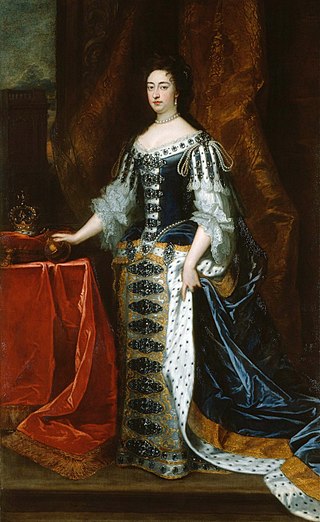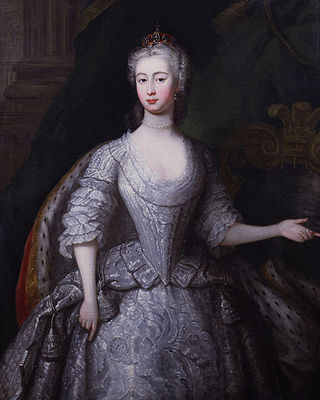Related Research Articles

Mary II was Queen of England, Scotland, and Ireland, co-reigning with her husband, William III & II, from 1689 until her death in 1694. She was also Princess of Orange following her marriage on 4 November 1677.

James Francis Edward Stuart, nicknamed the Old Pretender by Whigs, was the son of King James VII and II of England, Scotland and Ireland, and his second wife, Mary of Modena. He was Prince of Wales from July 1688 until, just months after his birth, his Catholic father was deposed and exiled in the Glorious Revolution of 1688. James II's Protestant elder daughter Mary II and her husband William III became co-monarchs. The Bill of Rights 1689 and Act of Settlement 1701 excluded Catholics such as James from the English and British thrones.

Mary of Modena was Queen of England, Scotland and Ireland as the second wife of James II and VII. A devout Catholic, Mary married the widower James, who was then the younger brother and heir presumptive of Charles II. She was uninterested in politics and devoted to James and their children, two of whom survived to adulthood: the Jacobite claimant to the thrones, James Francis Edward, and Louisa Maria Teresa.

Princess Augusta of Saxe-Gotha-Altenburg was Princess of Wales by marriage to Frederick, Prince of Wales, eldest son and heir apparent of King George II. She never became queen consort, as Frederick predeceased his father in 1751. Augusta's eldest son succeeded her father-in-law as George III in 1760. After her spouse died, Augusta was the presumptive regent of Great Britain in the event of a regency, until her son reached majority in 1756.

Antonin Nompar de Caumont, 1st Duke of Lauzun was a French courtier and soldier. He was the only love interest of the "greatest heiress in Europe", Anne Marie Louise d'Orléans, Duchess of Montpensier, cousin of Louis XIV.

Patrick Sarsfield, 1st Earl of Lucan was an Irish soldier and leading figure in the Jacobite army during the 1689 to 1691 Williamite War in Ireland.

The Williamite War in Ireland took place from March 1689 to October 1691. Fought between supporters of James II and his successor, William III, it resulted in a Williamite victory. It is generally viewed as a related conflict of the 1688 to 1697 Nine Years' War.

Theodore I of Corsica, born Freiherr Theodor Stephan von Neuhoff, was a German adventurer who was briefly King of Corsica. Theodore is the subject of an opera by Giovanni Paisiello, Il re Teodoro in Venezia, and one of the six kings in Venice in Voltaire's Candide.
Sarsfield is a surname of Norman origin that may refer to:

James Francis Fitz-James Stuart, 2nd Duke of Berwick, 2nd Duke of Liria and Xérica was a Jacobite and Spanish nobleman.

The Kingdom of Corsica was a short-lived kingdom on the island of Corsica. It was formed after the islanders crowned the German adventurer Theodor Stephan Freiherr von Neuhoff as King of Corsica.
John Hartstonge or Hartstongue was an English-born prelate of the Church of Ireland who became Bishop of Ossory and then Bishop of Derry.

Cécile Fatiman (1771-1883), was a Haitian vodou priestess, a mambo. She is famous for her participation in the vodou ceremony at Bois Caïman, which is considered to be one of the starting points of the Haitian Revolution.
Julia Gasper is an English independent academic specialising in early modern literature, and a right-wing political activist affiliated with the English Democrats. She formerly belonged to the UK Independence Party (UKIP). A vociferous critic of LGBT rights, she has generated controversy with comments widely deemed homophobic and transphobic.
Oliver O'Gara was an Irish politician and soldier of the 17th and 18th centuries who was closely identified with the Jacobite cause.
Terence O'Dempsey, 1st Viscount Clanmalier was an Irish aristocrat.

Honora Burke became Honora FitzJames, Duchess of Berwick on Tweed, married Patrick Sarsfield and went into French exile where he followed her soon afterwards. After his death at the Battle of Landen, she married James FitzJames, 1st Duke of Berwick, an illegitimate son of James II. She may have introduced the country dance to the French court.
David Sarsfield was an Irish soldier noted for his service in the Jacobite Army during the Williamite War in Ireland. After going into exile as part of the Flight of the Wild Geese, he later served in the Spanish Army. He was killed at the Battle of Villaviciosa in 1710.
Dominick Sarsfield, 4th Viscount Sarsfield was an Irish aristocrat and supporter of the Jacobite cause during the Williamite War in Ireland.
William Sarsfield was an Irish landowner of the seventeenth century. He was the elder brother of the Jacobite soldier Patrick Sarsfield.
References
- ↑ Gasper p.41
- ↑ Slater, Sharon (15 April 2017). "Catalina Sarsfield - the Queen of Corsica • People & Genealogy". limerickslife.com. Retrieved 2 November 2022.
- ↑ Gasper p.41